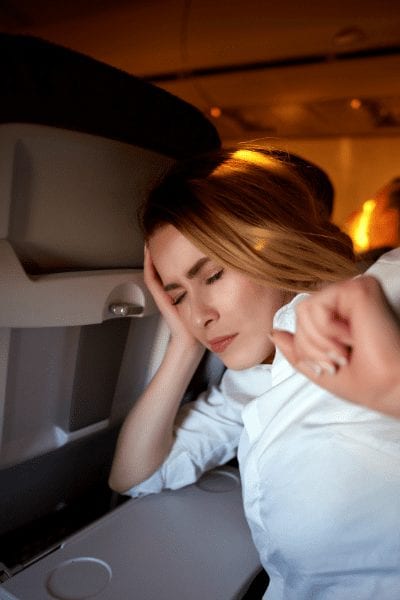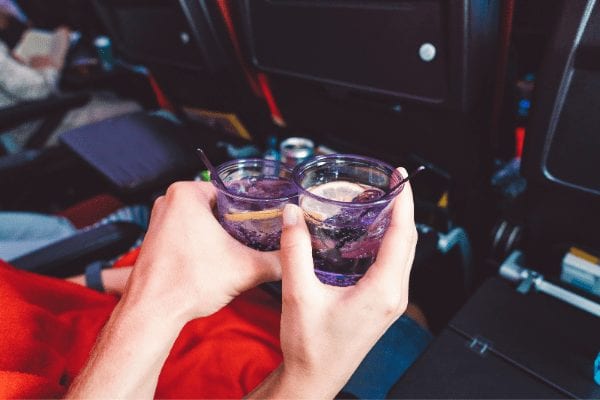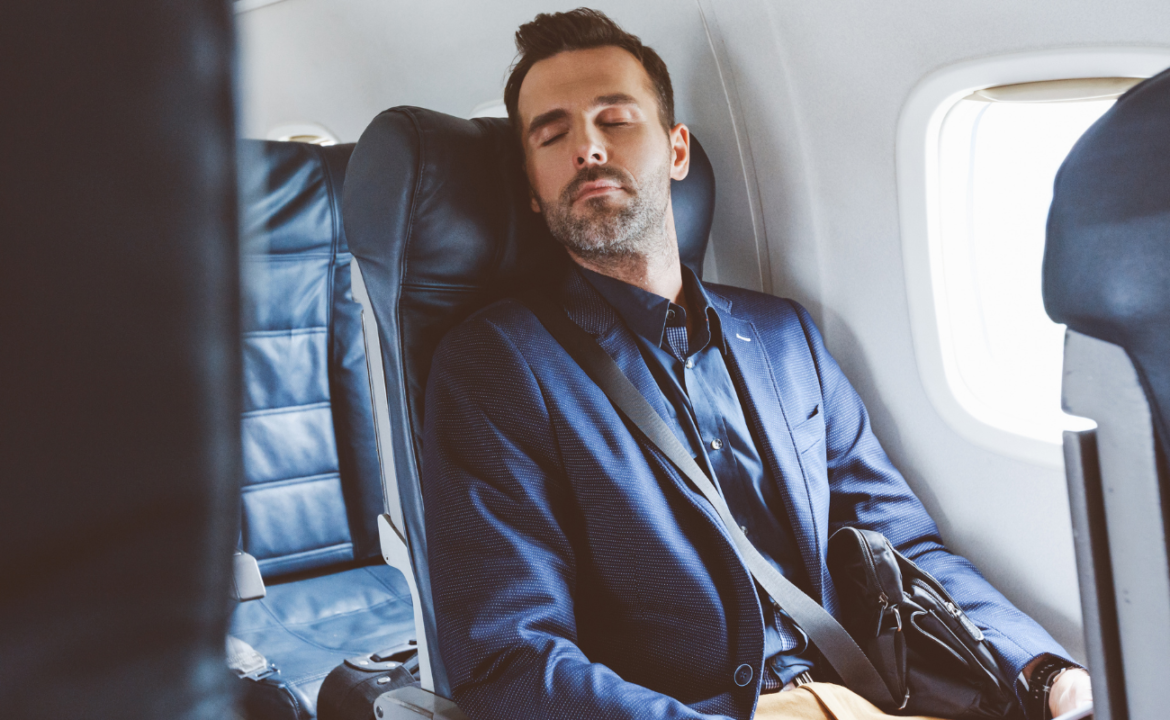Are you one of the lucky people who can fall asleep on a plane the minute your head hits the seat rest? For the rest of us, sleeping on planes is often very difficult. We can help. Here’s our practical guide on exactly how to sleep on a plane.
How to sleep on a plane (and yes, it can be done)
In this article you will learn the following:
- Why is it hard to sleep on a plane?
- How to sleep on a plane, including:
- Tips for sleeping on a plane
- What’s the best travel gear for airline sleep
- Where to sit on a plane if you want to sleep
- How to sleep in an economy class seat
- What about sleep aids on a plane?
Why is it so hard to sleep on a plane?
Sleeping on a plane is a challenge for many. You’ve probably been envious of those passengers who seem to be able to pass out for the entire flight. Their eyes flutter closed the minute their head hits the headrest while you squirm and wiggle trying to get comfortable in your seat, all the while wiping the sleep out of your eyes in between slugs of coffee.

It’s hard enough to sleep in a different bed (like a hotel bed when you are traveling) but sleeping on a plane can seem unattainable for many. You are not alone. Many people struggle sleeping on a flight and many simply don’t even try – regardless of the duration, time of day, or seat quality.
There are several common reasons why people struggle to sleep on flights:
- It’s not your bed
- Flying isn’t always the most comfortable experience
- Excitement about your destination can make you less tired
- Your diet may be keeping you awake
- There’s other people around you
The biggest reason people struggle to sleep on planes is simple: it’s not your bed. Whether you have a great bed or a crummy bed, it’s your bed and you’ve probably figured out how to sleep on it. Trying to sleep elsewhere – including an airplane seat can be difficult because it’s different from what your body and mind are used to.
Additionally, flying isn’t always the most comfortable experience. Economy seats, smelly passengers, the hum of the jet engine, people jostling you or your seat. The list goes on. Plus, you are probably trying to sleep upright which is, in and of itself, a difficult task.
The excitement of your trip can also keep you away. Maybe it’s a vacation you’ve got planned and your mind s playing out all the fun things you will do when you get there, or maybe it’s sheer exhaustion – that “too tired to sleep” feeling we’ve all had.
Diet plays a role too. Too much caffeine, not enough water, too much booze, or that spicy kimchi you at at the airport lounge.
Finally people may simply not be comfortable sleeping around other people or be embarrassed if they know they are a loud snorer.
It turns out quite a bit can keep you from drifting off to sleep on that flight.
7 Tips for Sleeping on Planes
Here are 7 tips for sleeping on planes:
- Seat location matters – window seats are better for sleeping
- Time of day is important – have realistic expectations
- Diet matters – including avoiding caffeine & booze
- Bring a pillow & maybe a blanket
- Avoid stuffing a carry on under the seat back – it cuts into your legroom
- Headphones are a must – even if just noise canceling
- Dress for sleep – comfortable layered clothing can helpT
Window seats tend to be better than aisle seats and always try to upgrade your seat – even if it’s just to a larger economy class seat. More on seating in a minute.

Travelers should be realistic about their expectations for sleep. If you are flying smack dab in the middle of the day it may be unrealistic to think you can catch some shuteye. Instead, bring a book. If you are traveling on a long haul flight you will need to consider the implication of jet lag and avoiding sleep or getting sleep – regardless of the time of day – may be critical to mitigating the effects of jet lag.
Your diet matters too. Are you dehydrated? Your body may struggle to get good sleep if you are dehydrated, according to sleep gurus, Leesa. Alcohol can affect your sleep patterns too. WebMD shared the findings of a study where it was determined that while booze might help you fall asleep faster it reduces the quality of your sleep.
A new review of 27 studies shows that alcohol does not improve sleep quality. According to the findings, alcohol does allow healthy people to fall asleep quicker and sleep more deeply for a while, but it reduces rapid eye movement (REM) sleep.
WebMD Report
Finally, the food you’ve eaten can affect your ability to sleep. Too spicy? Stomach issues…and that’s never fun. Not enough food? Hunger can keep can you awake.
Where you stow your bags and the type of gear you bring with you can improve your chances of falling asleep too. Whenever possible, give yourself as much foot room as you can by storing your carry-ons in the overhead compartment instead of under the seatback in front of you. Consider bringing a neck pillow, an eye mask, and maybe a travel blanket (we’ve provided recommendations on all of these, below).
Dress for sleep. Avoid uncomfortable clothes and wear layers if it makes sense. It’s easy to take a light jacket off if you are hot, or drape a sweater over your arms if chilly. Consider taking your shoes off too, but be sensitive to fellow passengers who don’t want to smell your nasty feet or see your toes draped over the arm rests.
Where to sit on a plane if you want to sleep
The best seat to sleep on an airplane is a window seat. Sleepy passengers can lean their head on the bulkhead (wall) of the plane making it easier to get comfortable and hopefully get to sleep. Window seat passengers also do not have to worry about fellow passengers bumping you as they walk down the aisle or being awoken by a middle or window seat passenger who needs to use the lavatory.
That said, the above guidance really applies to economy class tickets and short haul flights. Truly, the best seat to sleep on a plane is a lie flat business class seat or first class cabin often found on transcontinental flights. Obviously, being able to lie completely flat or mostly flat (depending on the plane) can go a long way towards allowing you to get some sleep.
However, even in a lie flat business class seat your choice of window or aisle can make a difference. For example, on a Lufthansa Airbus A330 (A333) the window version of the lie flat seat might be a better option than the aisle as the window seat may have to clamber over the aisle seat when it’s laid flat. Meaning, if you are in the aisle seat dreaming of your favorite hotel sheets at that dope Marriott you booked on points, you might get woken up by someone trying to sneak out.
Another element to consider in picking the optimal seat for a nap is the the actual location of the seat. The graphic above shows highlights Seat 10A, a lovely lie flat seat. However, the caption tells us an important piece of information: it’s near a bathroom (not to mention the galley). In addition to unpleasant odors, there may be residual light from the galley and lots of traffic from people queuing up to use the bathroom. Better to pick a seat a little farther away from such annoyances.
If you were fortunate enough to score an upgrade to “regular” first class seat (in other words medium to short haul flight with first class seats that don’t lay flat), again, the window seat is the best option for someone looking to sack out for the duration of the flight.
In short, the window seat is the best seat for sleeping on a plane in nearly all circumstances short of a first class cabin like travel blogger Sam Chui reviewed on a Singapore Airlines flight:
How to sleep in an economy class seat
Sleeping in an economy class seat is the most difficult place to sleep on a plane, particularly if it’s the basic level economy seat that many airlines now offer at extremely discounted pricing. Leg room? Good luck. Comfortable seats? Not here. But, sleeping in an economy seat can be done if you know what you are doing.
Here are a few practical tips for sleeping in an economy class airplane seat:
- Pick a window seat
- Keep room for your feet by stowing carry-ons in the overhead compartment
- Bring a neck pillow
- Wear comfortable clothes
- Wear noise canceling headphones
- Use the bathroom ahead of time
- Eat a simple, but filling meal that will be gentle on your tummy
If you can, do your best to avoid basic economy seats whenever you can. Aside from the challenges of sleeping in such a seat, you usually earn less points/miles in basic economy seats and they tend to be towards the back of the plane which means it probably will take you longer to get on and off the plane. Whenever possible, book the next level of economy class up from basic, and if you have status, hope for an upgrade. If you are a baller, just book the business class or first class seat.
What’s the best travel gear for airline sleep
A few travel gadgets or gear can go a long ways towards helping you catch a few z’s on your flight. We’ve identified a few must-have’s and a few optional items.
- Must Have Gadgets for Airplane Sleeping
- A good travel pillow
- Travel blanket or layered clothing
- Headphones
- Optional Gadgets for Sleeping while flying
- Eye mask
- Lumbar Support pad
A good travel pillow
The fundamental challenge with sleeping in an airplane seat is that you are sitting upright, which is, in and of itself, difficult to do. It can be very challenging to get your head and neck in a comfortable position. Finding a travel pillow that works for you can be a game-changer. We’ve reviewed several travel pillow options here, but, for our money, the Trtl Travel Pillow Plus is the best option (read our review here).

The Trtl Travel Pillow (Plus) helps you keep your head upright by supporting it on the frame of the pillow – which wears like a scarf (see pic below). In our review of the Trtl Plus we found the concept of sleeping with your head upright addresses a pretty significant challenge with sleeping on a plane: what to do with your head WHILE it’s upright. Most travel pillows really don’t address this fundamental problem and in fact, can make it worse by forcing your head forward and creating a crick in your neck.
Layered Clothing or a Travel Blanket
Airlines used to provide travel blankets (and pillows) on most flights. These days, it’s less common to find such items and if you do they are usually scooped up quickly or of poor quality. Instead, consider bringing your own travel blanket with you. Here’s one option, the Flight 001 Travel Blanket.

This travel blanket is small (but not too small – 55in x 55in), comfortable and easily packed and repacked. Airlines don’t provide blankets very often anymore and this great product is the perfect accessory for that long flight.
If you prefer to pack light, skip the blanket and wear a light jacket or sweatshirt that can easily be removed based on cabin temperature.
Quality Headphones and preferably noise canceling
Airplanes are noisy. The engine hum alone can drive you bonkers and forget about it if you have a chatty passenger next to you. One travel gadget worth investing in for every single trip are high-quality headphones, preferably ones with a noise-canceling option. We recommend the Bose Quiet Comfort II 35s.

Eye Mask to block light
If you are sensitive to light and have a hard time sleeping when it’s not completely dark, then pack an eye mask for your trip. An eye mask will help block out cabin light and help you get to sleep quicker and stay asleep. There is a multitude of options for eye masks, but we prefer ones with style including this fun one from Airportag:

Lumbarcushion for your back
If you need lumbar support this product could be a game-changer for you. It might also help you sleep as you can use it as a pillow.

What about sleep aids on the plane?
There are many options when it comes to sleep aids including melatonin, prescription-strength sleeping pills like Ambien, or tamer choices like ZZZQuil. We encourage caution when using sleep aids on a plane. Consult a medical professional for specific advice, but as a general rule, we suggest passengers avoid them. Being so completely asleep that you might struggle to wake up in the event of an emergency or to accommodate a fellow passenger is a recipe for disaster.
PS…if you want more reasons not to take Ambien on a flight read this CNN piece.
Conclusion
Yes, even you, weary traveler, can sleep on a plane. It may not always be the best night of sleep you’ve ever had, but it can be done if you employ the advice we’ve curated for you here. Happy traveling (and sleeping!).
Don’t forget to follow us on social media including Twitter, Instagram and Facebook. Join the conversation and leave us a comment below, too.


